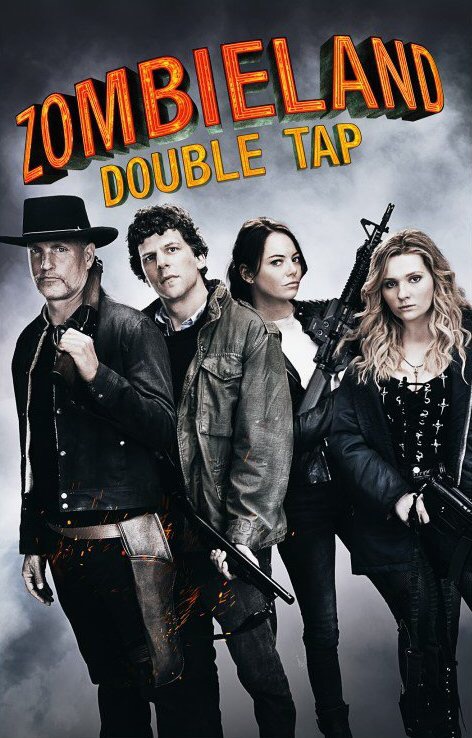Welcome to Zombieland…again!
Ten years after the original, “Zombieland: Double Tap” revisits Columbus (Jesse Eisenberg), Tallahassee (Woody Harrelson), Wichita (Emma Stone), and Little Rock (Abigail Breslin). The four friends are living within Zombieland and now reside in the White House. They have perfected the zombie-killing game, but new threats— both zombie-related and social— jeopardize the group.
An ongoing theme throughout both movies is the idea of chosen family. However, the newest film focuses more on the romantic relationships of the four. Columbus and Wichita struggle due to Wichita’s commitment issues and Columbus’ new “girlfriend,” Madison. Wichita left him for a month after he asked her to marry him, in which time he found a ditzy blonde survivor who had been living in a mall freezer. They hit it off, and Wichita returns the same day.
Little Rock, now an adult, is ready to “leave the nest” and make friends her own age. When she and Wichita leave, she finds a hippie boy from Berkeley (Avan Jogia) and leaves with him. Berkeley is a pacifist who travels with no weapons. This prompts the rest of the gang to seek her out and make sure she’s safe.
Tallahassee, while on the search for Little Rock, finds a woman called Nevada (Rosario Dawson). They bond over their tough attitudes and love for Elvis, and decide to stick together.
While it was nice to see familiar characters faced with new problems, the comedy level is far below that of the original film. The occasional sarcastic comment, along with “dumb” characters, made up a majority of the comedy, and many of the bits are not thought out.
The main plot lines seemed underdeveloped. In the opening of the movie, Columbus explains the three tiers of zombies, called “Homers,” “Hawkings,” and “Ninjas.” However, a new strain of zombies has emerged, called “T-800s.” These zombies are faster, stronger, and harder to kill than the original.
Throughout the movie, the T-800s are made out to be a serious threat. However, they aren’t presented much differently than the average zombie.
Also, none of the other zombie types are revisited besides “Homers,” in which they’re shown for one moment doing something idiotic.
Another sub-par moment was the “doubles” bit. When Tallahassee, Columbus, and Wichita are staying with Nevada, two men who seem to be exact parallels of the original men show up. Albuquerque, a country gun-loving cowboy, gives Tallahassee a hard time and tries to out-macho him.
Flagstaff, an awkward soft-spoken man, starts comparing his “commandments” with Columbus’ infamous rules.
These new characters are short-lived, however, as they go to fight a few of the T-800 zombies and get bitten. This leads into a fight of Columbus and Tallahassee versus their zombie parallels.
While much of the old formatting was preserved, such as the rules appearing on screen and “Zombie Kill of the Week,” the new film lacked in energy, plot, and humor that defined the original film.
Despite this, those who enjoyed the original film should not be completely discouraged from catching “Zombieland: Double Tap.” It was enjoyable to revisit the gang further down the road.
Also, moviegoers should make sure to stick around for the mid-credits scene. Bill Murray makes an appearance, taking place before the events of the first movie. It’s arguably the best scene of the entire movie.
Despite this, those who enjoyed the original film should not be completely discouraged from catching “Zombieland: Double Tap.” It was enjoyable to revisit the gang further down the road.
Also, moviegoers should make sure to stick around for the mid-credits scene. Bill Murray makes an appearance, taking place before the events of the first movie. It’s arguably the best scene of the entire movie.


